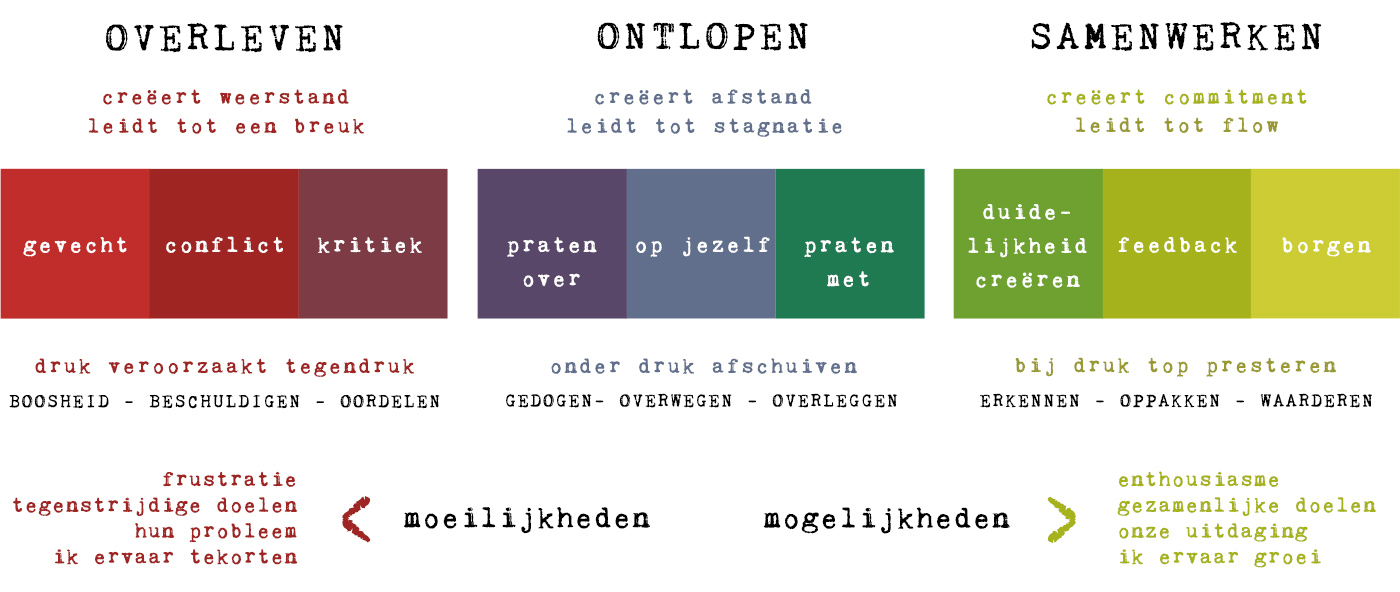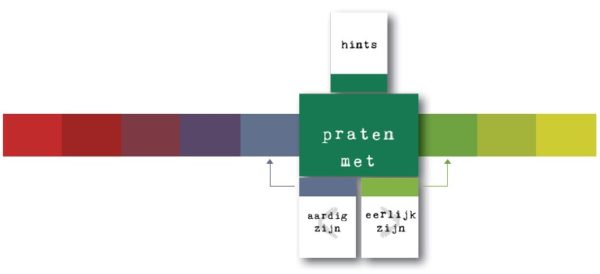
A roadmap in eight layers
People who have ever experienced true cooperation know that one plus one becomes more than two in a team. You achieve much more together if you are willing to share and learn from each other. That is the basic idea behind the Scale of Cooperation, the quest for a cooperative attitude to life. We experience daily in our work that ultimately we all grow when we are open to working together and sharing.
The Scale of Cooperation is a model for understanding how groups of people work together. We prefer to call it a roadmap. Of course, it is a simplification of reality, namely, what you see on the map is not reality, however, looking at the map does give you a useful way of gaining insight and an overview of where a group stands. Once we know where the group is, the following task is to think about the first step to get the group closer to optimal cooperation because that is our aim!
The Scale of Cooperation has eight layers. Read about how the layers were created here.
A manual has been written about the Scale. You can order the manual here and read the first chapter here.
Layer 1 - three worlds
At the base of the roadmap is the approach to cooperation from three directions: Struggling, Avoiding and Cooperating.

Three 'worlds', each with its gravitational force, in which people usually want to "stick" together.
Layer 2 - the impact of the behaviour
- The struggling behaviour propagates continuous struggling behaviour. One focuses on 'we vs they': 'Are you with us or against us?' Conflict constantly lurks around the group. When you face each other, the hair gets bristled. Who will win this fight?
Struggling behaviour creates resistance.
- If one person is avoidant, the probability is high that someone else will become the same: sentences like 'I will take my time with this decision'. And 'I say 'yes' (but it will take a while and I might do 'no'). In this world, we give each other vague hints and complain about each other.
Avoiding behaviour creates distance.
- In a cooperative setting, everyone feels the energy to keep the momentum going optimally. If someone 'slips' they are quickly supported by others to get back on track: 'Let's do it together, we need you!' There is an incentive, you are appreciated. Working on something, alone or together, gives energy.
Cooperative behaviour creates trust.

Layer 3 - nine positions
Layer 5 - characteristic behaviours by position
We later divided each world into three positions. This created nine positions where a group or a team could stand and also showed the position's behavioural tendency.
In the image above, we have numbered the positions. This way you can quickly identify where a team can stand on a bad and good day. Is there a lot of complaining going on without the person concerned knowing it? You are in position 4. Are you willing to acknowledge that you also have a role in solving a problem? You are standing in position 7.
It is important to realise that a team usually moves between 3 to 4 contiguous positions. Between 4 and 6, for example. Here everyone works hard and alone, sometimes complaining about each other and also remaining respectful and friendly when talking to each other. They are avoiding inconvenient subjects in the team. Is it that bad there? Yes, it is in the long run and people miss many opportunities. Team members become increasingly distant from each other. People get sick and overworked and there is a sense of pulling a dead weight. Yet there is often a lack of awareness that things can be done much better, with much more fun and better results.
Layer 4 - the direction of view
To move across the Scale, the perspective from which one observes a situation is decisive. If one is mainly talking about the problems then the direction of observing is to the left on the Scale. Then it doesn't matter what position that is - in such situations, there is some rethinking needed. We call it thinking in possibilities instead of difficulties. But that is only possible once the difficulties have first been addressed. What is actually standing in the way? A deficit? A lack? A limitation? Only then does thinking in terms of possibilities become fruitful.

Layer 6 - the twenty-seven action cards
Action cards are a relatively new addition to the Scale. They emerged during the times when we trained teams - when the group looked at the trainers and asked, 'Yes, right now we are here, but now what? How do we get out of here again?'
Some of the action cards have been in use for a long time. For instance, a feature of 'Talking with' is that people give each other vague hints. Hints have become an action card, a feature of an avoidant group in conversation. 'Talking with' is a common position where team members also feel safe. Nothing becomes concrete just yet and whether a hint is cemented with a follow-up remains to be seen. 'We need to work better together', everyone nods 'yes', but who is going to do what, to improve cooperation - remains unclear.

The 'Talking with' position has two more action cards as each position has three. A team is talking and that is important. But is anything being agreed on? It is important to understand whether the team just 'stays nice' or also becomes 'honest'. These are the second and third action cards. To give each other optimal Feedback, becoming also honest is a prerequisite. If people stay just nice, the problem is unlikely to be solved.
In the manual all 27 action cards are described in detail in two chapters.

Layer 7 - keys or triggers to the three worlds
Cooperation seems so simple and yet in practice there is quite a lot involved! What is needed, what are the actual conditions, or, as we like to say, the triggers or keys by which Cooperation leads to enthusiasm? One of the three keys to Cooperation is: acknowledgement. Acknowledgement in the sense that each team member realises that an achievement is a joint achievement and a mistake is a joint mistake. Each team member recognises that he or she too can do something better when something goes wrong. This recognition is essential and can be even better understood when contrasted with 'blaming each other'. If someone else is to blame, I don't have to do anything else. But that does not lead to cooperation! To achieve good cooperation, each team member will have to be willing to acknowledge his or her part in the solution and to become accountable. Accountability is the second trigger. Without action, no success. Blaming each other takes enormous energy, and being accountable for your part energises the whole team. From this, appreciation unfolds. Appreciation is the third key. The order of the triggers is not that important; any other order will give the same result. However, all three are needed.
Layer 8 - characteristics of the three worlds
Layer 8 is actually the oldest layer of all. Older even than layer 1. Once, in a team training session, we started by asking 'What behaviours do you like to see your colleagues do?" That became a list on a flipchart. Then we asked what behaviour each of the participants would like to see less of. That also became a list on a flipchart. Layer 8 is a collection of hundreds of lists. Sometimes there were great finds in there. For example, about the role of humour in a Cooperating (constructive humour), Disengaging (distracting humour) and Struggling world, in which humour is harsh and person-centred. The role of humour has thus become one of the 17 traits in layer 8.
Another great find: Being right is something that fits Struggling and being happy fits Cooperation, where enthusiasm and granting each other space is something important. Thus the question arises when a conflict seems to be around winning or losing: 'But what do you really want? Equality or happiness?'
It really has become a very beautiful layer, perhaps the most beautiful. You can enjoy quietly reading the manual by a campfire or the fireplace, be touched by it, and then apply it to your own team or in a training or coaching session.
The Scale is an evolving model
The world changes and so does the way people work together. We also continue to gain new insights, knowledge and experience on the topic of cooperation. This is why we also continue to develop the Scale, to create an updated roadmap to help people and teams understand and develop cooperation in the best possible way.
Since 2024, a new version of the Scale
The trigger for another major change was the first Scale of Cooperation International Meeting on January 2023.
We then asked participants "What are you running into as a facilitator?" and "What tools are you still missing to help groups get over this 'threshold'?" We were surprised ourselves at the agreement in the responses. That got us thinking.
Lots of groups are talking to each other, but are struggling to arrive at light, helpful and insightful feedback - which is positively perceived. In June 2023, we ventured to add a new position between Talking with and Feedback and remove all the positions and action cards we were not using enough from the ground sheets. Thus came the position 'Creating Clarity' on the Scale. First in a beta version that some trainers started testing with and since 2024 on the official new version of the Scale.
Can I still use the 2019 version?
Yes of course, by paying extra attention to what is needed between 'talking to' and 'feedback' you join in - we look forward to chatting with you and finding answers to the unanswered or ignored questions together.
You can email us if you want to work with a group in which this very step is important if you want to receive more information and share the outcomes. Please use our contact form.
All older versions without action cards from 2018 and older are not recommended for use anymore.
